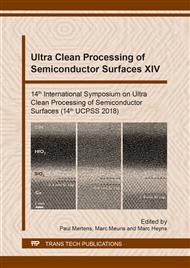p.94
p.101
p.107
p.113
p.121
p.126
p.132
p.141
p.147
Customized Chemical Compositions Adaptable for Cleaning Virtually all Post-Etch Residues
Abstract:
A post-etch residue cleaning formulation, based on balancing the aggressiveness of hydrofluoric acid with its well-known residue removal properties is introduced. In a series of investigations originally motivated by the cleaning challenge provided by high-k dielectric-based residues, a formulation platform is developed that successfully cleans residues resulting from the plasma patterning of tantalum oxide and similar materials while maintaining metal and dielectric compatibility. It is further shown that the fundamental advantages of this solution can be extended to the cleaning of other, more traditional post-etch residues, with no sacrifice in compatibility, as demonstrated by measurements on blanket films and through SEM data.
Info:
Periodical:
Pages:
121-125
Citation:
Online since:
August 2018
Keywords:
Price:
Сopyright:
© 2018 Trans Tech Publications Ltd. All Rights Reserved
Share:
Citation:


